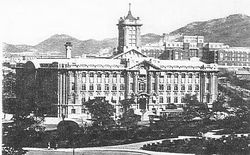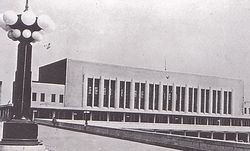كوانتونغ، الأرض المستأجرة
| كوانتونگ، الأرض المستأجرة 關東州 | |||||||||
|---|---|---|---|---|---|---|---|---|---|
| أرض مستأجَرة امبراطورية اليابان | |||||||||
| 1905–1945 | |||||||||
 كوانتونگ، الأرض المستأجرة في 1921. منطقة نفوذ ومنطقة محايدة. | |||||||||
| العاصمة | دايرن | ||||||||
| التاريخ | |||||||||
| الحكومة | |||||||||
| امبراطور اليابان | |||||||||
• 1905–1912 | الامبراطور مـِيْجي | ||||||||
• 1912–1926 | الامبراطور تايشو | ||||||||
• 1926–1945 | الامبراطور شوا | ||||||||
| العصر التاريخي | امبراطورية اليابان | ||||||||
| 17 أبريل 1895 | |||||||||
| 23 أبريل 1895 | |||||||||
| 5 سبتمبر 1905 | |||||||||
| 14 أغسطس 1945 | |||||||||
| |||||||||
| اليوم جزء من | الصين | ||||||||
| كوانتونغ، الأرض المستأجرة | |||
|---|---|---|---|
| الاسم الصيني | |||
| الصينية التقليدية | 關東州 | ||
| الصينية المبسطة | 关东州 | ||
| |||
| Japanese name | |||
| كانجي | 關東州 | ||
| كانا | かんとうしゅう | ||
| شينجيتاي | 関東州 | ||
| |||
كوانتونگ، الأرض المستأجرة كانت أرضاً في الجزء الجنوبي من شبه جزيرة لياونينگ (يابانية: 遼東半島) في جمهورية الصين تواجدت من 1898 حتى 1945. وكانت واحدة من امتيازات إقليمية عديدة أُجبـِرت أسرة تشينگ على منحها للدول الأجنبية في نهاية القرن 19. الأرض ضمت the militarily and economically significant ports of Lüshunkou (Port Arthur, Port-Artur in Russian, or Ryojun in Japanese) and Dalian (Dalniy, Dal'nii in Russian, or Dairen in Japanese).
The name Kwantung, or Guāndōng (關東) in pinyin, means "east of Shanhai Pass", a reference to part of Qinhuangdao in today's Hebei province, at the eastern end of the Great Wall of China. The name originally referred to all of Manchuria but later came to be used more narrowly for the area of the leased territory. In Japanese it is pronounced Kantō and it is often referred to a s Kantō-shū to avoid confusion with the Kantō region surrounding the capital Tokyo.
التاريخ
In Qing dynasty China, the Liaodong Peninsula was administratively part of لياونينگ Province. In 1882, the Beiyang Fleet established a naval base and coaling station at Lüshunkou near the southern end of the peninsula.
The Empire of Japan occupied the region during the First Sino-Japanese War (1894–1895), and under the terms of the معاهدة شيمونوسكي signed by Japan and China ending the war in April 1895, Japan gained full sovereignty of the area. However, within weeks, Germany, France and Russia pressured Japan to cede the territory back to China, in what was called the Triple Intervention.[1]
In December 1897, Russian naval vessels entered Lüshunkou harbor, which they began to use as a forward base of operations for patrols off of northern China, Korea and in the Sea of Japan. The Russian Empire renamed the harbor Port Arthur. In March 1898 Russia formally leased the region for 25 years from China. The leased area extended to the northern shore of Yadang Bay on the western side of the peninsula; on the eastern side it reached Pikou; Yevgeni Ivanovich Alekseyev, chief of Russian Pacific Fleet, became the head of this territory. The peninsula north of the lease was made a neutral territory in which China agreed not to offer concessions to other countries. In 1899, Russia founded the town of Dalniy (meaning "distant" or "remote"), just north of the naval base at Port Arthur. This would later become the city of Dalian (Dairen).
In 1898 Russia began building a railroad north from Port Arthur to link Dalniy with the Chinese Eastern Railway at Harbin; this spur line was the South Manchurian Railway.
Under the Portsmouth Treaty (1905) resulting from the Russo-Japanese War, Japan replaced Russia as leaseholder. Port Arthur was renamed Ryojun, and Dalniy was renamed Dairen. Japan also obtained extraterritorial rights in the region north of the territory adjacent to the 885 kilometres (550 mi) South Manchurian Railway in 1905 (i.e. the South Manchurian Railway Zone), which was extended north of Mukden to Changchun. These rights, along with the railway and several spur lines were passed to the corporation known as the South Manchurian Railway Company.[2]
Japan established the Kwantung Governor-general (関東都督府, Kantō Totokufu) to administer the new territory, and based the Kwantung Garrison to defend it and the railway. The Kwantung Garrison later became the Kwantung Army, which played an instrumental role in the founding of Manchukuo. In negotiations with the Republic of China under the Twenty-One Demands, the terms of the lease of the Kwantung Leased Territory were extended to 99 years, or until 1997 (as the British did in Hong Kong's New Territories).
After the foundation of Japanese-controlled Manchukuo in 1932, Japan regarded the sovereignty of the leased territory as transferred from China to Manchukuo. A new lease agreement was contracted between Japan and the government of Manchukuo, and Japan transferred the South Manchurian Railway Zone to Manchukuo. However, Japan retained the Kwantung Leased Territory as a territory apart from the nominally-independent Manchukuo until its surrender at the end of World War II in 1945.
After World War II, the Soviet Union occupied the territory and the Soviet Navy made use of the Ryojun Naval Base. The Soviet Union turned it over to the People's Republic of China in 1955.
الاقتصاد
Massive capital investment was concentrated in Dairen (now the capital of the territory), wherein Japanese firms developed a significant industrial infrastructure, as well as creating a first class port out of the mediocre natural harbor. The facilities of the port at Dairen and its free trade port status made it the principal trade gateway to northeast China. The South Manchurian Railway Company was headquartered in Dairen, and some of the profits from its operation were channelled into transforming Dairen into a showcase city of modern city planning and modern architecture, with hospitals, universities and a large industrial zone.[3]
الديمغرافيا
In the Japanese national census of 1935, the population of the Kwantung Leased Territory was 1,034,074, of whom 168,185 were Japanese nationals. The numbers excluded military personnel. The area of the territory was 3,500 square kilometres (1,350 sq mi).
الحكام العموم لكوانتونگ، المنطقة المستأجرة
| # | الاسم | من | إلى |
|---|---|---|---|
| 1 | General Baron Yoshimasa Ōshima (大島義昌) | October 10, 1905 | April 26, 1912 |
| 2 | Lieutenant General Yasumasa Fukushima (福島安正) | April 26, 1912 | September 15, 1914 |
| 3 | Lieutenant General Akira Nakamura (中村覚) | September 15, 1914 | July 31, 1917 |
| 4 | Lieutenant General Yujiro Nakamura (中村雄次郎) | July 31, 1917 | April 12, 1919 |
| 5 | Gonsuke Hayashi (林権助) | April 12, 1919 | May 24, 1920 |
| 6 | Isaburo Yamagata (山県伊三郎) | May 24, 1920 | September 8, 1922 |
| 7 | Ijuin Hikokichi (伊集院彦吉) | September 8, 1922 | September 19, 1923 |
| 8 | Hideo Kodama (児玉秀雄) | September 26, 1923 | December 17, 1927 |
| 9 | Kenjiro Kinoshita (木下謙次郎) | December 17, 1927 | August 17, 1929 |
| 10 | Masahiro Ota (太田政弘) | August 17, 1929 | January 16, 1931 |
| 11 | Seiji Tsukamoto (塚本清治) | January 16, 1931 | January 11, 1932 |
| 12 | Mannosuke Yamaoka (山岡万之助) | January 11, 1932 | August 8, 1932 |
| 13 | General Nobuyoshi Mutō (武藤信義) | August 8, 1932 | July 28, 1933 |
| 14 | General Takashi Hishikari (菱刈隆) | July 28, 1933 | December 10, 1934 |
| 15 | General Jirō Minami (南次郎) | December 10, 1934 | March 6, 1936 |
| 16 | General Kenkichi Ueda (植田謙吉) | March 6, 1936 | September 7, 1939 |
| 17 | General Yoshijirō Umezu (梅津美治郎) | September 7, 1939 | July 18, 1944 |
| 18 | General Otozō Yamada (山田乙三) | July 18, 1944 | August 28, 1945 |
انظر أيضاً
المراجع
- Coox, Alvin (1990). Nomonhan: Japan Against Russia, 1939. Stanford University Press. ISBN 0-8047-1835-0.
- Hsu, Immanuel C.Y. (1999). The Rise of Modern China. Oxford University Press. ISBN 0-19-512504-5.
- Low, Morris (2005). Building a Modern Japan: Science, Technology, and Medicine in the Meiji Era and Beyond. Palgrave Macmillan. ISBN 1-4039-6832-2.
- Quigley, Harold S (2007) [1932]. Japanese Government and Politics. Thomson Press. ISBN 1-4067-2260-X.
- Young, Louise (1999). Japan's Total Empire: Manchuria and the Culture of Wartime Imperialism. University of California Press. ISBN 0-520-21934-1.
Notes
وصلات خارجية
- Pages using gadget WikiMiniAtlas
- Short description is different from Wikidata
- Articles with hatnote templates targeting a nonexistent page
- Missing redirects
- Former country articles requiring maintenance
- Articles containing صينية-language text
- Coordinates on Wikidata
- Kwantung Leased Territory
- امتيازات في الصين
- Former Japanese colonies
- History of Liaoning
- العلاقات الخارجية لأسرة تشينگ
- تاريخ منشوريا
- History of the Republic of China
- Republic of China (1912–49)
- بحر بوهاي
- Yellow Sea
- 1895 establishments in China
- 1945 disestablishments in China
- 1895 establishments in the Japanese colonial empire
- 1945 disestablishments in the Japanese colonial empire
- China–Japan relations





